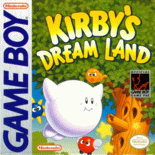
































Kirby’s Dream Land

Kirby's Dream Land is a side-scrolling action platform video game developed by HAL Laboratory and published by Nintendo for the Game Boy. Released in 1992, it is the first video game in the Kirby series and the debut of Kirby. As the inaugural Kirby title it created many conventions that would appear in later games in the series.
Kirby's Dream Land was designed by Masahiro Sakurai, who intended it to be a simple game that could be easy to pick up and play by those unfamiliar with action games. For more advanced players, he offered additional optional challenges such as an unlockable hard mode and the ability to edit Kirby's maximum HP and starting number of lives. Kirby's Dream Land was re-released on the Nintendo 3DS via the Virtual Console in 2011 and is also one of the games included in the compilation game Kirby's Dream Collection for the Wii, released to celebrate Kirby's 20th anniversary.
One night, under the cover of darkness, the gluttonous King Dedede and his minions steal all the food in Dream Land as well as the Sparkling Stars used to obtain more food. The next morning as the residents are discussing what to do, a spry little boy named Kirby, steps forward and volunteers to retrieve the food and stars, and stop Dedede.
Kirby's Dream Land is an action-platformer. Like many other platformers of the 8-bit and 16-bit era of video games, levels are side-scrolling, played on a two-dimensional plane in which Kirby can move left or right as well as jump. Kirby's main method of attack is to inhale enemies and objects into his mouth, after which the player can either swallow them or spit them out as a projectile attack. In addition to running and jumping, Kirby can fly by inflating himself with a mouthful of air and flapping his arms. Flying can be done indefinitely; however, while flying, Kirby's only method of attack is to release the air puff held in his mouth which cancels his flight.
The game consists of a total of five levels. Levels are made up of a series of large 'rooms' connected by doors that lead Kirby to different areas, rather than the single continuous corridors typical of platformers at the time. Some of these doors lead to hidden areas or alternate pathways through the level. The doors act as checkpoints returning the player to the beginning of a 'room' should they die rather than starting the level over. The goal of the game is to clear the level by defeating the boss at the end. If Kirby touches an enemy or an dangerous object, he loses one or more of his health, depending on the enemy or obstacle he touched. If all of his health is lost, or he falls into a bottomless pit, the player loses a life. Losing all lives results in a game over. Kirby can recover lost health by eating food, found across the stage.
Unlike the copy abilities of later titles, Kirby's Dream Land has more traditional power-ups that offer Kirby temporary abilities when he picks them up. These often appear in the form of food, such as Spicy Curry that gives Kirby fire breath or a Mint Leaf (Sweet Potato in the Japanese version) that lets Kirby fire air puffs rapidly without losing flight. At the end of each level is a boss Kirby must fight to obtain one of the Sparkling Stars. Most bosses are fought by sucking up small objects or projectiles created by the boss' attacks and spitting them back at the boss. The third boss, Kaboola, is fought using an unlimited version of the Mint Leaf item, incorporating shoot 'em up elements. The last level before the final boss consists of a boss rush, where Kirby must fight all of the game's bosses again going through a short area based on that boss's home level.
Like many 1980s-era platformers, the player can accumulate points by defeating enemies and collecting items, with an extra life granted when the player has enough points. However, because Kirby's Dream Land lacks a save function, scores are not recorded. Also, there are no save files, so the player has to start over again when the Game Boy is turned off, if the player chooses to return to the title screen after a game over, or if the player resets the game. Once the game has been completed, a code is offered to play an optional extra game, in which the difficulty is significantly increased. Completing the extra game offered a second code that lets the player adjust lives and vitality settings to play an easier or even harder game, and listen to music and sound effects freely.
How to play:
Click on the joystick icon in the Kirby’s Dream Land online emulator to see how to control the Kirby’s Dream Land game









































Comments